
HOME
INTRO
SYMBOLS
ALMANAC
ECONOMY
GEOGRAPHY
STATE MAPS
PEOPLE
FORUM
NEWS
COOL SCHOOLS
STATE QUIZ
STATE LINKS
BOOK STORE
MARKETPLACE
NETSTATE.STORE
NETSTATE.MALL
GUESTBOOK
CONTACT US


Tweet
Double click on word for definition.
Georgia State Marine Mammal
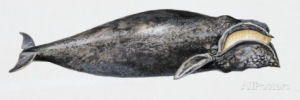
Georgia State Marine Mammal: Right Whale
Photographs, prints, posters
The right whale was named by 19th century whalers because, simply, they deemed it the right whale to hunt. The whales were large, they lived close to shore, swam slowly and they floated when they were killed. It was the low hanging fruit, so to speak, of the industry.
Hunting and killing the right whale paid off handsomely as the large mammals yielded valuable products such as whale oil for lamps and baleen for corset ribbing, called stays.
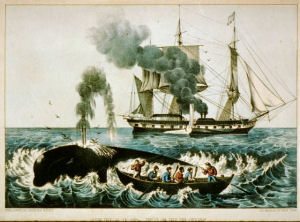
Currier & Ives Whale fishery: attacking a right whale
Library of Congress Prints and Photographs Division
Washington, D.C. 20540
The combination of characteristics that made the right whale the right whale to hunt made it easy prey for whalers of the 19th and early 20th centuries and, due to dwindling populations and fears of extinction, an international ban on hunting of right whales was implemented in 1935.
The hunting had stopped in theory, but the population of North Atlantic right whales did not rebound. The whale’s new enemies included ship collisions, entanglement in gill nets, lobster lines, and other fishing gear, general pollution and, perhaps, climate change that is impacting their food supplies.
In 1983, Scott Krause, a biologist with the New England Aquarium in Boston, Mass., had been studying the North Atlantic right whale for eight years and it was estimated that there were no more than 300 remaining.
Kraus knew that the whales summered off the coast of Maine in the Bay of Fundy and he knew that they left the bay in the fall and that their migration had been tracked to Cape Cod, on the Massachusetts coast.
He knew that New England whalers had hunted the right whales along the Georgia and Florida coasts in the 1880s and he knew that there had been right whale sightings in those areas since.
He was determined, now, to discover what was unknown. He wanted to find calving grounds of the rapidly declining species.
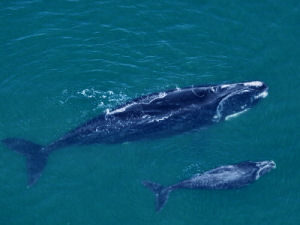
Georgia State Marine Mammal: Right Whale
Photographs, prints, posters
In February, 1984, Kraus and several volunteer Delta Airlines pilots surveyed an area along the Georgia coast for five days. The pilots brought home photographs of 15 right whales (10 adults, 4 babies, called calves, and 1 juvenile).
Kraus immediately identified one from the Georgia group as one from the Bay of Fundy. Upon further study, he was able to identify more. This was great news, but he did not consider it decisive.
Kraus returned in 1985 to confirm his suspicions.
The right whale became the official Georgia state marine mammal upon approval of Senate Resolution No. 91 on April 02, 1985.
Its adoption followed the exciting discovery of the unknown calving ground of the right whale off the Georgia coast in 1985. The North Atlantic right whale is considered the only member of the great whale group that is native to Georgia.
In August, 1985, a headline in the New York Times was to declare
Right whale's calving grounds found
(New York Times "Right whale's calving grounds found" 13)
Hans N. Neuhauser, zoologist and environmentalist who ran the coastal Georgia office of the Georgia Conservancy in Savannah and worked closely with Kraus commented on the adoption of the right whale as Georgia’s official state marine mammal in the New Georgia Encyclopedia online in 2004.
It was so designated because the only known calving grounds for the species lie within fifteen miles of the Georgia and north Florida coastline. The North Atlantic right whale is also the world's most endangered large whale, with fewer than 350 individuals remaining. Scientists estimate that unless threats from ship strikes and fishing-gear entanglements can be substantially reduced, the species will become extinct within 200 years.
(Neuhauser "Right Whales")
RIGHT WHALE DESIGNATED AS THE OFFICIAL GEORGIA STATE MARINE MAMMAL.
No. 48 (Senate Resolution No. 91)
A RESOLUTION
Designating the right whale as the official Georgia state marine mammal; and for other purposes.
WHEREAS, although the State of Georgia has designated flowers, birds, a mineral, a fossil, a fish, a tree, an insect, and a gem as official symbols of Georgia, she has never had a state marine mammal; and
WHEREAS, in 1980, photographers from the Department of Natural Resources discovered and photographed a right whale off the Georgia coast; and
WHEREAS, those photographs were the basis for an expedition to the area by the New England Aquarium, since the whale was familiar to them and known to them as Fermata; and
WHEREAS, the expedition, led by a group of Delta Airlines pilots from Atlanta, again sighted Fermata with a newborn calf and during the expedition sighted 14 more adult whales and four newborn calves; and
WHEREAS, the coastal waters of Georgia were found to be the heretofore unknown calving grounds of the North Atlantic Right Whale, the only known member of the great whale group that is native to Georgia; and
WHEREAS, the discovery of the Georgia calving grounds is one of the most exciting discoveries in the study of marine mammals and will add to the knowledge that is vital to the survival of this species.
NOW, THEREFORE, BE IT RESOLVED BY THE GENERAL ASSEMBLY OF GEORGIA that the right whale is designated as the official Georgia state marine mammal.
Approved April 2, 1985.
Though Senate Resolution No. 91 does not specifically name a species or even designate the "North Atlantic" right whale the official marine mammal, Eubalaena glacialis is the only species present in the North Atlantic Ocean
Two other states share the North Atlantic right whale as an official symbol.
Massachusetts designated the North Atlantic right whale its official state marine mammal in 1980.
South Carolina adopted the "Northern" right whale as its official state migratory marine mammal in 2009. South Carolina adopted Eubalaena glacialis as the "Northern" right whale rather than the "North Atlantic" right whale. It's the same whale.
As of 2014, the North Atlantic right whale is listed as "Endangered," a species that is in danger of extinction throughout all or a significant portion of its range, on the National Oceanic and Atmospheric Administration's Endangered Species List.
Sources...
"ACTS AND RESOLUTIONS OF THE GENERAL ASSEMBLY OF THE STATE OF GEORGIA 1985 ." GALILEO: Georgia Legislative Documents. Secretary of State: Georgia Archives, 2 Apr. 1985. Web. 25 Aug. 2014. .
Neuhauser, Hans N.. "Right Whales." New Georgia Encyclopedia. N.p., 11 Feb. 2013. Web. 22 Aug. 2014. .
New York Times. "Right whale's calving grounds found." Stars and Stripes [Tokyo] 12 Aug. 1985, Pacific ed., sec. Science: 13. Print.
Shearer, Benjamin F. and Barbara S. State Names, Seals, Flags and Symbols: A Historical Guide Third Edition, Revised and Expanded. Westport, Conn: Greenwood Press, 3 Sub edition, 2001.
Schulz, Bill. "Search for whales goes on." The Intelligencer [Dowlestown] 24 Feb. 1985, Sunday ed., sec. B: 17. Print.
Additional Information
North Atlantic Right Whale Fact Sheet: Defenders of Wildlife website.
Right Whale Eubalaena glacialis: National Geographic: Animals.
North Atlantic Right Whale (Eubalaena glacialis): Smithsonian Institution: Ocean Portal.
North Atlantic Right Whale Eubalaena glacialis: The New England Aquarium.
North Atlantic Right Whales (Eubalaena glacialis): The National Oceanic and Atmospheric Administration's Office of Protected Resources.
Whale Facts: North Atlantic Right Whale Consortium.
North Atlantic Right Whale: World Wildlife Fund.
Eubalaena glacialis North Atlantic Right Whale: The Encyclopedia of Life v2: Providing Global Access to Knowledge About Life on Earth.
Eubalaena glacialis (North Atlantic Right Whale): The University of Michigan Museum of Zoology: Animal Diversity Web.
Eubaleana glacialis - (Müller, 1776) North Atlantic Right Whale: A network connecting science with conservation - NatureServe Explorer: An Online Encyclopedia of Life.
Eubaleana glacialis (Müller, 1776): Integrated Taxonomic Information System (ITIS) Here you will find authoritative taxonomic information on plants, animals, fungi, and microbes of North America and the world.
State marine mammals: Complete list of official state marine mammals from NETSTATE.COM
More symbols & emblems: Complete list of official Georgia state symbols from NETSTATE.COM.
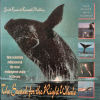
The Search for
the Right Whale
Scott Kraus
Kenneth Mallory
The Search for the Right Whale, by Scott Kraus and Kenneth Mallory. 36 pages. Publisher: Knopf Books for Young Readers (May 11, 1993) Reading level: Ages 9-12. In addition to accurate and current information, young readers expect to be entertained. It is this successful combination of elements which makes The Search for Right Whale a remarkable book.
Authors Scott Kraus and Kenneth Mallory provide readers with an investigation of the North Atlantic right whale, including whale history, biology, and conservation. Readers learn the process of how scientists gather and analyze information as they trace the path of the rarest whale in the ocean along the Atlantic Coast. The material presented is the result of more than a decade of contributions and cooperative efforts by researchers from Massachusetts to Florida.
An interesting history of the right whale is presented and is documented with prints and information from whaling ship log books. Unique characteristics of the right whale, such as the V-shaped spout, and the importance of the patterns of callosities for the identification of individual whales, are explained. Migration patterns and behavior of the right whales are explored with engaging style. The richly informative text is accompanied by many excellent photos, maps, and historical prints and drawings.

Disappearing Giants
Disappearing Giants: The North Atlantic Right Whale, by Scott Kraus and Kenneth Mallory. 48 pages. Publisher: Bunker Hill Publishing (October 7, 2004) The North Atlantic right whale is the most endangered large whale in the oceans today. This is a story of science and rediscovery, of survival and protection, and of research, without which we cannot hope to protect the right whale’s habitat.

Right Whales
Phil Clapham
Right Whales, by Phil Clapham. 72 pages. Publisher: Voyageur Press (November 29, 2004) Right Whales covers the characteristics (life history, group life, reproduction, mortality) and ecology of these creatures. Phil Clapham also discusses the serious threats that right whales face, and informs readers about what can be done to protect them.
This book is an excellent general introduction that’s full of fascinating facts and fabulous four-color photographs. It presents scientific insights and information in a way that is both readable and highly enjoyable for a popular audience.
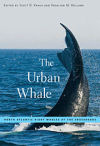
The Urban Whale
The Urban Whale: North Atlantic Right Whales at the Crossroads, edited by Scott D. Kraus and Rosalind M. Rolland. 576 pages. Publisher: Harvard University Press (March 30, 2010) In 1980 a group of scientists censusing marine mammals in the Bay of Fundy was astonished at the sight of 25 right whales. It was, one scientist later recalled, "like finding a brontosaurus in the backyard." Until that time, scientists believed the North Atlantic right whale was extinct or nearly so. The sightings electrified the research community, spurring a quarter century of exploration, which is documented here.
The authors present our current knowledge about the biology and plight of right whales, including their reproduction, feeding, genetics, and endocrinology, as well as fatal run-ins with ships and fishing gear. Employing individual identifications, acoustics, and population models, Scott Kraus, Rosalind Rolland, and their colleagues present a vivid history of this animal, from a once commercially hunted commodity to today’s life-threatening challenges of urban waters. Hunted for nearly a millennium, right whales are now being killed by the ocean commerce that supports our modern way of life. This book offers hope for the eventual salvation of this great whale.

